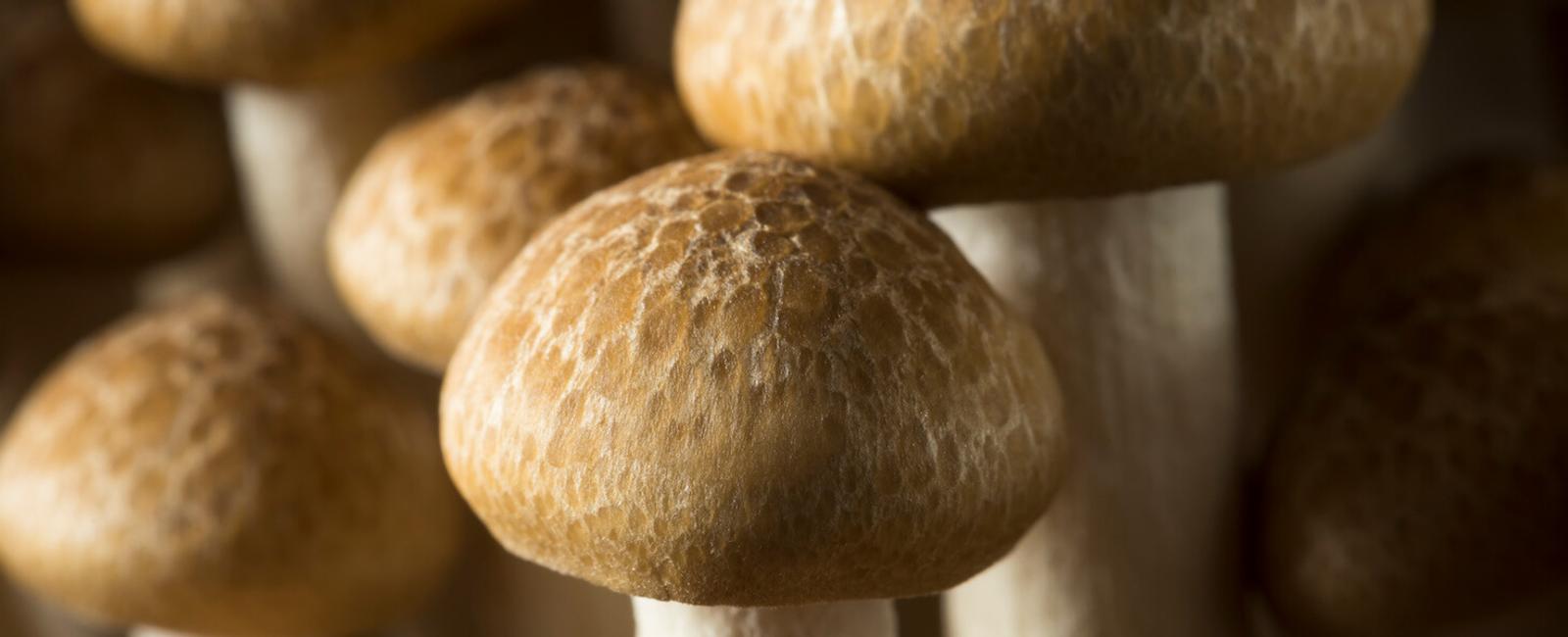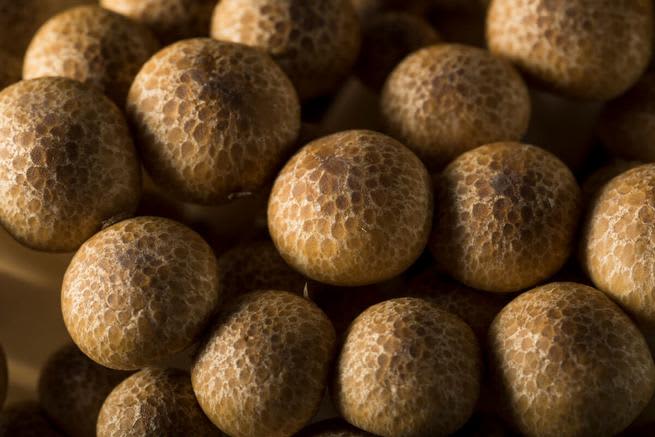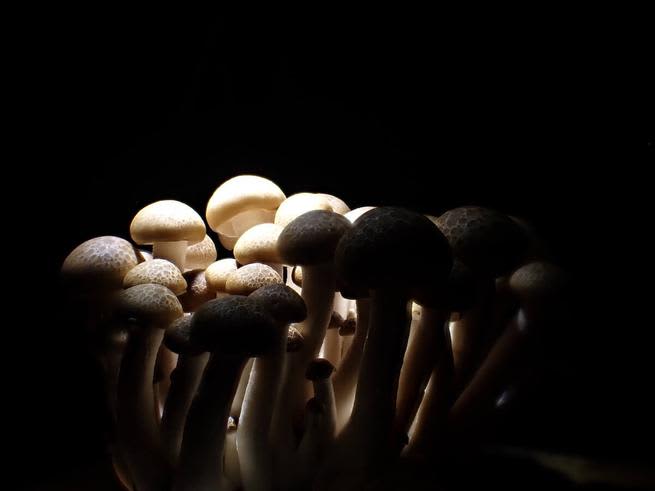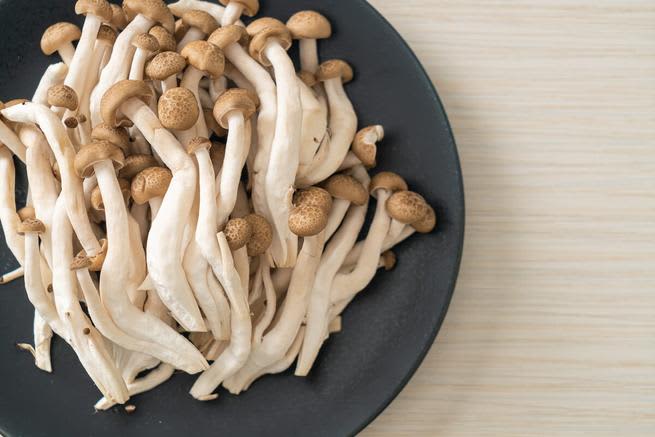

Beech mushrooms are among the top choices for amateur and professional cooks alike. A true staple of Japanese cuisine, these fungi are known for their delicious taste, tender texture, and culinary versatility.
Yet, these mushrooms may be much more than that—recent research shows they could have significant anticancer and antioxidant properties. They may even combat specific bacteria. Here’s everything you need to know.
What are beech mushrooms?
Beech mushrooms, scientifically known as Hypsizygus tessulatus, are an edible species known for their unique and delicious fragrance and taste. H. tessulatus is widely known in China, Japan, and other East Asia countries. However, it has grown in popularity in parts of Europe and North America in recent years.
As you might’ve guessed, the common name “beech mushrooms” comes from this species’ preferred growing grounds, which is among decaying beech trees. It also goes by many other nicknames, including (1):
- Buna-shimeji or bunapi-shimeji
- Hon-shimeji
- Japanese honey mushroom
- Brown clamshell mushroom
- White clamshell mushroom
Beech mushrooms are some of the most essential fungi fitting under the Japanese umbrella concept of “shimeji mushrooms.” It’s hard to define precisely what shimeji means—but it comprises the most sought-after edible mushrooms in Japan and the rest of Asia.
Other species that fall under the shimeji category include Lyophyllum shimeji, Lyophyllum decastes, and Hypsizygus ulmarius. That said, most experts agree that H. tessulatus is the authentic shimeji species (2).
The species’ flavor is often described as being bitter, sharp, and tough when raw. However, cooking it will render a tender texture with the delicious, sophisticated taste of herbs and nuts. The aroma is also worth noting, often described as being piquant and savory (1).
How does Hypsizygus tessulatus look?

The type H. tessulatus has a 2–7 cm (0.8–2.7 in) cap that initially grows incurved but flattens as the mushroom ages. The species is known for having “water spots” on the cap, which give the mushrooms a marbled look. Usually, the cap is dark tan, fading to a pale gray or beige as the fungi grows older.
The stem can vary wildly depending on where the mushroom is growing—some specimens show almost no stem while others develop a tall one that makes them poke out over other fungi. The spore print is entirely white (2).
What are the varieties of beech mushrooms?

There are two main varieties of beech mushrooms: brown hon-shimeji and white hon-shimeji. There’s not much difference between the two besides the color. In fact, experts point out that white beech mushrooms aren’t found in nature often, as they’re mostly a mutation of the original species.
However, the interesting part is that these two varieties don’t have any scientific names to distinguish them from each other. If you find white and brown shimejis at the grocery store, just remember they have the same taste and nutritional values (1) (3).
History of beech mushrooms

Edible mushrooms have a long history of use by Asian cultures. For example, early mycological records in China date back as far as 1245. Ancient Japan and Korea also have historical records of early descriptions of edible fungi—which, although rudimentary, help us understand the link between mushrooms and ancient cultures.
Everything indicates that traditional Asian cultures considered mushrooms elixirs of life and absolute delicacies. However, none of these records mentions shimeji fungi specifically, instead focusing on other species such as shiitakes (4) (5).
The first official mention of shimejis dates back to 1791, when Pierre Bulliard described the species under the name “Agaricus tessulatus.” Howard Bigelow later transferred it over to the Hypsizygus genus in 1872.
Since then, not much has changed besides the Japanese company Takara Holdings patenting the white variety in 1972. However, in recent years, research has sparked to find and determine the “true shimeji”—but breakthroughs in the area are yet to be seen (2).
Health benefits of beech mushrooms

Beech mushrooms are part of what’s known as “functional fungi”—species with significant health and nutritional benefits. Yet, not much is known about the medicinal potential of these wonderful mushrooms, as research is far and between.
Nutrition-wise, dried shimeji mushrooms comprise about 67% carbohydrates, 22% protein, and 5% fat. The leftover percentage is mainly composed of fiber and ash. However, it’s important to remember that, when fresh, shimeji fungi are composed of about 90% water (6).
As for health benefits, H. tessulatus is associated with anticancer activities. Experts suggest this has to do with the mushroom inhibiting certain cell components crucial for cancer proliferation (7).
Similarly, a 2018 study showed that bioactive compounds present in the species have significant antioxidant properties. While research is still in its early stages, the authors theorize that these fungi could help manage conditions such as diabetes and Alzheimer’s disease in the future (8).
The same study also looked into the antibacterial activities of shimeji fungi. Surprisingly, they found that buna-shimeji mushrooms have moderate inhibition against common bacteria, such as Serratia marcescens and Escherichia coli (8).
Although these results are promising, it’s important to remember that you shouldn’t attempt to use H. tessulatus for medicinal purposes without the supervision of a professional. If you think shimeji fungi could help you manage a specific condition, check with a doctor first.
Where do beech mushrooms grow?
As its common name indicates, beech mushrooms grow among beech trees and other hardwoods where they feed on dead or waste wood—a process called saprotrophic nutrition. Usually, they grow in small clusters of two or three specimens.
Beech mushrooms are present in hardwood forests throughout Europe, Asia, and North America. They seem to prefer temperate regions and tend to grow during fall. However, artificially cultivated shimeji fungi are available year-round.
Luckily, growing shimeji mushrooms at home isn’t too complicated. Experts recommend inoculating logs or stumps with the spores near fall and partially burying them outdoors near shady areas. In a few weeks, you’ll have formed a rich mycelium capable of growing fruiting bodies as soon as temperatures drop (1) (2)!
What is ethical wildcrafting?
Ethical wildcrafting refers to harvesting natural resources with specific care to avoid damaging the surrounding ecosystem. Wildcrafting is often confused with foraging—the key difference is that the former refers to harvesting for medicinal purposes and the latter for eating.
Unfortunately, many mushroom hunters don’t know that picking wild fungi carelessly can severely impact the local animal, tree, and mushroom populations. But don’t worry. Avoiding ecological damage is as simple as following these rules of thumb:
- Research and take note of any endangered or poisonous lookalikes you may find along the way.
- Pick the mushrooms gently and carefully, only using scissors and knives when absolutely necessary.
- Don’t overharvest. Take only what you need and avoid sharing patch locations with others.
- Ask for the land owner’s permission (if you’re wildcrafting on private land)
- Check local harvesting laws (if you’re wildcrafting on public land)
If it’s your first time harvesting, you might want to look for mushroom-hunting groups in your area. Veteran fungi lovers will usually be more than glad to show you how to pick and harvest mushrooms ethically—while also keeping you away from dangerous lookalikes.
Is it safe to wildcraft for Hypsizygus tessulatus?
Unfortunately, it’s never 100% safe to eat wild-picked mushrooms. No matter the species, there’s always the risk of coming across a non-edible or even poisonous lookalike. In the case of H. tessulatus, the most similar lookalike is Hypsizygus ulmarius. Fortunately, this species is completely edible—although it doesn’t taste as good.
Furthermore, wild-picked mushrooms often carry toxins from the environment, which can lead to indigestion and other gastrointestinal discomfort. If you’re set on eating wild mushrooms, make sure to wash and cook them thoroughly.
How do you take beech mushrooms?

Beech mushrooms are incredibly versatile—their crunchy yet tender texture and mild flavor are a welcome addition to almost any plate. Risotto, soups, and stir-fries are some of the most common choices for these fungi, but don’t be afraid to experiment.
If you’re new to cooking with mushrooms, the internet is filled with hundreds of beech mushroom recipes for you to try out. Here are a few examples we’ve gathered.
Japanese stew
To make a delicious Japanese mushroom stew, cook some rice while you wash and cut shimeji mushrooms, garlic, shallots, and tomatoes. Whisk together wine, broth, soy sauce, and tomato paste in a bowl. Then, warm some olive oil in a deep skillet and cook the shallots and garlic. Add the tomato and mushrooms when they’re done, stir for a bit, and pour in the wine mixture. Finally, let it simmer for about 20 minutes over high heat and serve on top of the rice.
Asparagus and mushrooms
If you’re looking for a simpler option, wash and cut some asparagus and shimeji mushrooms while you heat a bit of olive oil in two non-stick pans. Cook the asparagus and mushrooms separately until they’ve developed some color. Once they’re each sautéed thoroughly, add butter, garlic, and lemon juice and serve for a delicious yet healthy meal.
As always, we recommend adding other fresh mushrooms when cooking with shimeji fungi. Almost every species pairs well with H. tessulatus, including:
- Shiitake mushrooms
- Oyster mushrooms
- Button mushrooms
- Maitake mushrooms (hen of the woods)
- Portobello mushrooms
- Enoki mushrooms
- Baby bellas
Most of these fungi are very forgiving when it comes to cooking methods and versatility, making them the perfect choices for newcomers to the mushroom world. However, always make sure you clean and cook them thoroughly beforehand.
Beech mushrooms: A versatile shimeji
Beech mushrooms and all the other shimeji species are a staple of Japanese cuisine. Known for their sophisticated taste and versatility, these fabulous fungi have become one of the top choices for professional and amateur cooks worldwide.
If you want to find out about other types of mushrooms, keep up on shroomer for everything about psychedelic and functional fungi to the latest news on edible mushrooms.
References
- Specialty Produce. “Brown Hon Shimeji Mushrooms.” (Last accessed August 22, 2023). https://www.specialtyproduce.com/produce/brown_hon_shimeji_mushrooms_5174.php
- Paul Stamets, “The Beech Mushrooms,” in Growing Gourmet and Medicinal Mushrooms (1993), 246–254.
- Specialty Produce. “White Hon Shimeji Mushrooms.” (Last accessed August 22, 2023). https://www.specialtyproduce.com/produce/white_hon_shimeji_mushrooms_5568.php
- Wang Yun-Chang. “Mycology in ancient China.” Mycologist 1(2) (1987): 59–61. https://doi.org/10.1016/S0269-915X(87)80040-X
- Jayne Chen. “Mushrooms in East Asian Culture: An Exploration of the Medicinal & Spiritual Facets of Fungi.” Macaulay Honors College (2018): 1–13.
- FoodData Central. “Mushroom, beech.” October 2021. https://fdc.nal.usda.gov/fdc-app.html#/food-details/2003603/nutrients
- C. I. Ukaegbu, S. R. Shah, H. A. Hamid, Z. Normaiza, O. R. Alara. “Extracts of Hypsizygus tessellatus (white var.) caps inhibited MCF-7 and MDA-MB-231 cell lines proliferation.” Journal of Food Measurement and Characterization (2018). https://doi.org/10.1007/s11694-018-9952-8
- C. I. Ukaegbu, S. R. Shah, H. A. Hamid, Z. Normaiza, O. R. Alara. “Evaluation of antioxidant and antibacterial activities of the stems of Flammulina velutipes and Hypsizygus tessellatus (white and brown var.) extracted with different solvents.” Journal of Food Measurement and Characterization (2018). https://doi.org/10.1007/s11694-018-9810-8


